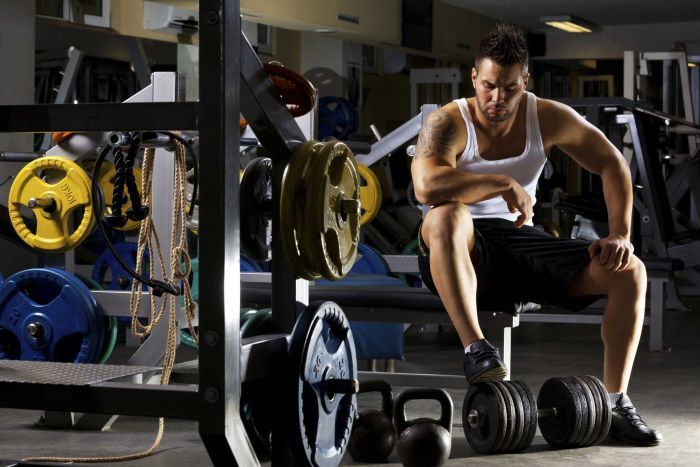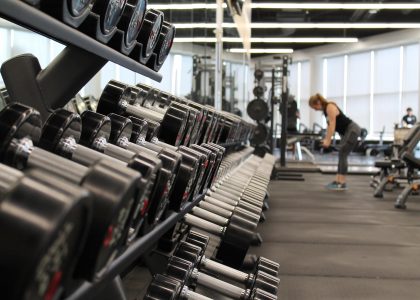That’s a shame, because training against high resistance or with heavy weights has health and visual advantages.
In order to dispel the most important prejudices and myths on the subject, I invited a guest author who knows what she is writing about.
Be inspired by Melanie!
Melanie, by the way, is an advocate of training with heavy weights and therefore writes about it in her article. You could just as easily achieve similar effects with your own body weight, of course. You can read more about this in my article weight training without equipment.
Women should stay away from heavy weights in order not to become a Hulk – and instead rely on stomach, legs, buttocks and circuit training?
Many myths about strength training as a woman still persist – these are 5 myths that you shouldn’t believe anymore!
Myth 1: Strength training makes women the Hulk
What is the first thing you think of when you hear “women strength training”? Many women primarily shoot Arnold Schwarzenegger or Hulk in the head. Quite intimidating – there are hardly any girls who want to look like professional bodybuilders. That’s why they don’t even touch a dumbbell.
But most women forget one thing above all: Arnie didn’t get such a body overnight either. For him, this included decades of (almost) daily training, extremely optimized nutrition, iron discipline and, in this case, anabolic steroids (doping). To look like this as a woman, it would take a lot more.
Conversely, this means: even if you train intensively as a woman for years and eat optimally, you will not look anything like Arnie and Co. So there is no reason to be afraid of heavy training and exploding mountains of muscles!
Benefits of strength training for women
On the contrary – strength training will on the one hand help you to improve your quality of life and also to achieve your dream body . If you build up muscles, you will benefit in many ways:
- You strengthen your whole body with it. This makes it more functional in everyday life – you can carry moving boxes, shopping bags and the like yourself without any problems.
- You prevent many diseases in old age, such as osteoporosis. With strength training you can also potentially reduce your blood pressure (Cornelissen, 2005), improve your blood lipid levels and your sugar metabolism, which can help prevent metabolic diseases such as diabetes (Winett & Carpinelli, 2001).
- With built-up muscles you tighten the overlying fat tissue – and thus effectively reduce cellulite.
- You shape your body with muscles according to your wishes. A tight buttocks, trained stomach and firm legs are the result of targeted, intensive strength training – and you can even make your waist appear narrower by training your lats!
So there are a few good reasons to get rid of the fear of strength training – and finally to start!
Myth 2: Weight training for women is different from weight training for men
Heavy weights are for men! Less weight and more repetitions – that’s how you train as a woman, right? Regardless of whether women strength training or men strength training – high resistance or heavy weights are necessary for both sexes in order to achieve positive effects.
Pink 1kg dumbbells, 15+ reps and abs / legs / buttocks are especially popular with women when they go to the gym. But real success can hardly be achieved with it.
What you need to know about effective strength training
In fact, the same rules apply to women in strength training as to men. These basic principles are:
- Train every muscle group in your body equally – including your chest, shoulders and back!
- As a beginner, save up with the isolation exercises. Choose basic exercises as the basis of your training. These are exercises that work several muscle groups at the same time – squats, deadlifts, bench presses, shoulder presses, lat pulls / pull-ups, barbell rows.
- Learn how to perform the exercise correctly and use the full range of motion for each exercise.
- For muscle building, mainly stay in the rep range of 6-15 (other rep ranges work as well – but you train most effectively in this range).
- Choose a weight that challenges you but that you can still do properly. If your weight becomes too light, increase it – long-term increase is the basic principle of building muscle!
- Challenge yourself! Strength training is not a children’s birthday party – only what challenges you bring success.
You can read in this blog post on Squats, Greens & Proteins how you can train optimally in order to build muscles (and what you absolutely have to pay attention to).

Myth 3: You gain weight from strength training – and to lose weight you do cardio
A recommendation that unfortunately is still given by many trainers in the gym: do strength training to build muscle and cardio training to lose weight.
While the former is not entirely wrong (after all, you need a training stimulus to build muscle – which, by the way, does not necessarily mean “weight”), “cardio for weight loss” is unfortunately quite wrong.
Because cardio does not automatically make the kilos tumble. What makes you lose fat is a long-term calorie deficit. That means – you burn more calories than you get through food. Although you can achieve this deficit through cardio, it is primarily your diet that you have to adjust for fat loss.
Myth 4: You need ab training for a six-pack
Have you had more than a 30-day sit-up challenge, but the six-pack is still a long way off?
Whether or not you have a visible six-pack simply depends on your body fat percentage – and this can primarily be influenced by your diet. Even if you train your abs on a daily basis, it will have little effect on whether or not you have a six-pack.Unfortunately, the myth persists that abdominal training gives you one Six pack, still stubborn. If this were correct, we would all be lying on the beach with our core toned – but that’s not the case.
In fact, explicit ab training isn’t necessary to get a six-pack. If you train effectively, do basic exercises and build up muscles all over your body, you automatically train your core with it – so that your own abdominal workout may even be completely superfluous.
Myth 5: Strength training is dangerous
Many women do not dare to do barbell etc. in the gym because they are simply afraid of doing something wrong. The biggest mistake is not to even try!
Strength training is basically not an extremely dangerous sport. It only becomes risky when it comes to overconfidence and the weight gain cannot go fast enough. Then injuries or overload symptoms occur.
Ideally, you will have a competent trainer explain all exercises to you and monitor your exercise execution. Invest a few weeks at the start of your training career to learn and practice performing the basic exercises before you start increasing the weights. This ensures that you can really train injury-free for the long term – and thus achieve success – !
Conclusion – No more women strength training myths!
Girls, the days when the gym was an all-male domain are over. We women benefit from training in a variety of ways – not just in terms of health or our appearance.
With strength and muscles, our self-confidence grows bit by bit through strength training. It’s time to get rid of your fear of weight training and conquer the free weight area!







